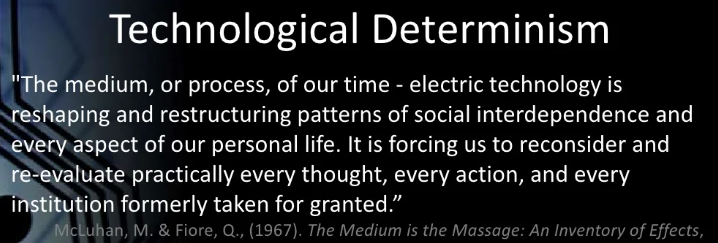Many are skeptical of the idea that "metaverse" will really develop as a three-dimensional, persistent and immersive experience widely used by people, businesses and organizations. It might not be inevitable, but it is probable.
Perhaps it is a form of technological determinism to assume that because a technology exists, it must be inevitable; must succeed in shaping economies, culture and social relationships. It is not a new idea, having gained notoriety in the late 1960s in Marshall McLuhan’s book Understanding Media.
In the book, a seminal chapter, called The Medium is the Message, makes the argument that new technology reflects human culture and also shapes it. That might seem an unremarkable assertion.
But, like all assertions that there is one root cause of human social relations, institutions and culture, it can be challenged as being reductionist: explaining wildly-complex outcomes as a result of just one driver.
McLuhan argued that technology, not content--how we communicate, not what we say--is determinant of impact. In other words, the actual content of media is irrelevant. Only the media form matters.

source: Alan Hook, Slideshare
We are never very far from accepting this sort of thinking.
Consider the way policymakers, regulators, analysts and much of the general public likely agrees that “broadband is a necessity” because it causes economic development, education and social inclusion. Policymakes and advocates often argue that faster broadband likewise drives higher economic growth.
Correlation, though, is not causation. Virtually all government programs to close the digital divide are touted as important because--it is argued--broadband leads to economic growth. In fact, careful reports only use the word correlation, not “causation” when discussing broadband and economic growth.
Of course, lots of things also correlate with economic growth. The rule of law, population density, educational attainment, household income, household wealth, transportation networks, proximity to the oceans, or other sources of comparative advantage are known to correlate with economic growth.
The same sort of thinking might arguably be advanced for 5G, personal computing devices, some applications, blockchain, web3 or the metaverse.
The phrase “X changes everything” is an example of such thinking. In place of “humans use tools” we get “Tools shape humans.” Again, most people would perceive a grain of truth; perhaps many grains.
One might argue that air conditioning was responsible for the current economic resilience and growth of the U.S. South, for example.
The point is that it is never inevitable that any technology “must or will succeed,” simply because it can be brought into existence. Any new successful technology succeeds because it solves real problems.
Computing devices and 5G succeed because they solve real problems: the need to access the internet and communicate in the former case; the ability to support quality experiences in the latter case.
It is said that the novel Upgrade contains a conversation between two people, discussing two-dimensional media: “I can’t watch the flats. Hurts my eyes.” “Me too. It’s unnatural.”
The novel is a warning about the dangers of the metaverse, to be sure. But the element of realism--whether something seems natural or lifelike or not--is among the reasons some of us might believe the metaverse ultimately will develop.
Simply, the history of all electronic media is an evolution towards more realism. Realism might be defined as the experience that “you are there,” realism approaches “real life” experiences: three dimensional, interactive, using multiple senses.
Think about the experience of participating in a sport, watching others play a sport live in a stadium, watching it on television or listening on radio, viewing a photo of the game or hearing somebody talk about a great play during that game, reading a story about that game or viewing an artist’s rendition of a key moment in a game.
The point is that there are degrees of immersion and realism, and that the degree of realism has tended to improve in the eras of electronic media. Consider augmented reality and virtual reality as part of that movement towards full metaverse.
Though not perhaps inevitable, the history of electronic media suggests it is likely, simply because humans prefer greater realism in electronic media. That is why television displaced radio; why sound replaced “silent” movies; why color prevailed; why stereo and surround sound are popular; why HDTV replaced NTSC; why experiments with 3D experiences continue.
